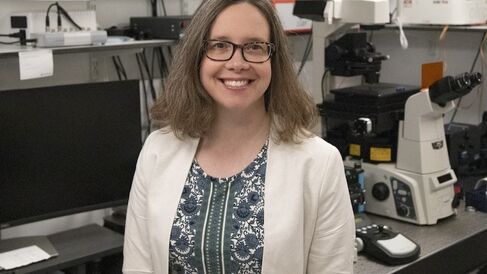Jenny Gallop

Signalling to the actin cytoskeleton.
Cells move during embryonic development and throughout the life of an organism. When they move, cells reorganise a system of filaments (the actin cytoskeleton) that gives them their shape and exerts force on the surrounding tissues. When regulation of the actin cytoskeleton is disrupted it can lead to cancer metastasis, intellectual disability, kidney dysfunction and other problems.
The Gallop Group studies how the actin cytoskeleton is assembled in different ways. The cell membrane is an important site of control of actin rearrangements because it is the boundary between the outside and inside of the cell and is responsible for initiating communication between and within cells, which is called signalling. We have developed cell-free systems using phospholipid bilayers and frog egg extracts that allow us to find out how signalling lipids in the cell membrane precisely control the molecular events of actin assembly. We combine these cell-free systems with the use of fruit flies, frog embryos and cultured human cells to test and generate hypotheses about the molecular events underlying actin regulation during development and in disease.
Research objectives
How do filopodia form?
What are the mechanisms of PI3K signalling to actin?
How can we intervene in the regulation of actin therapeutically?
Key publications
Vaishnav P*, Shimo Kondo H*, Gadsby JR, Dobramysl U, Mason J, Atherton J, Gallop JL (2025).Membrane composition and curvature in SNX9-mediated actin polymerization. Mol Biol Cell 36(5):ar54. doi: 10.1091/mbc.E24-09-0419
Gadsby JR, Ioannou P, Mason J, Butler R, Smith A, Chin S, Dobson CJ, Gallop JL (2024). ‘The actin filament open to closed D-loop conformational switch as a length determinant of filopodia-like actin bundles’ Biochem J. 481(24):1977-1995. doi: 10.1042/BCJ20240367
Blake TCA, Fox HM, Urbančič V, Ravishankar R, Wolowczyk A, Allgeyer ES, Mason J, Danuser G, Gallop JL (2024). Filopodial protrusion driven by density-dependent Ena-TOCA-1 interactions. J Cell Sci. doi: 10.1242/jcs.261057
Blake TCA and Gallop JL (2024). Filopodia in vitro and in vivo. Annual Reviews in Cell and Developmental Biology 39:307-329. doi: 10.1146/annurev-cellbio-020223-025210
Dobramysl U*, Jarsch IK*, Inoue I*, Shimo H*, Richier B, Gadsby JR, Mason J, Szalapak A, Ioannou P, Correia Pereira G, Walrant A, Butler R, Hannezo E, Simons BD, Gallop JL (2021). Stochastic combinations of actin regulatory proteins are sufficient to drive filopodia formation. J Cell Biol 220(4): e202003052. doi: 10.1083/jcb.202003052
Berquez M*, Gadsby JR*, Festa BP*, Butler R, Jackson SP, Berno V, Luciani A, Devuyst O, Gallop JL (2020). The phosphoinositide 3-kinase inhibitor alpelisib restores actin organization and improves proximal tubule dysfunction in vitro and in a mouse model of Lowe syndrome and Dent disease. Kidney Int 98:883-896. doi: 10.1016/j.kint.2020.05.040
Jarsch IK, Gadsby JR, Nuccitelli A, Mason J, Shimo H, Pilloux L, Marzook B, Mulvey CM, Dobramysl U, Bradshaw CR, Lilley KS, Hayward RD, Vaughan TJ, Dobson CL, Gallop JL (2020). A direct role for SNX9 in the biogenesis of filopodia. J. Cell Biol., 219(4):e201909178. doi: 10.1083/jcb.201909178
Richier B, Inoue Y, Dobramysl U, Friedlander J, Brown NH, Gallop JL (2018). Integrin signaling downregulates filopodia during muscle-tendon attachment. J. Cell Sci., 131(16):jcs217133. doi: 10.1242/jcs.217133
Daste F, Walrant A, Holst MR, Gadsby JR, Mason J, Lee JE, Brook D, Mettlen M, Larsson E, Lee SF, Lundmark R, Gallop JL (2017). Control of actin polymerization via the coincidence of phosphoinositides and high membrane curvature. J. Cell Biol., 216(11):3745-3765. doi: 10.1083/jcb.201704061
Urbančič V, Butler R, Richier B, Peter M, Mason J, Livesey FJ, Holt CE, Gallop JL (2017). Filopodyan: An open-source pipeline for the analysis of filopodia. J. Cell Biol., 216(10):3405-3422. doi: 10.1083/jcb.201705113
Gallop JL, Walrant A, Cantley LC, Kirschner MW (2013). Phosphoinositides and membrane curvature switch the mode of actin polymerization via selective recruitment of toca-1 and Snx9. Proc. Natl. Acad. Sci. U.S.A., 110(18):7193-7198. doi: 10.1073/pnas.1305286110
